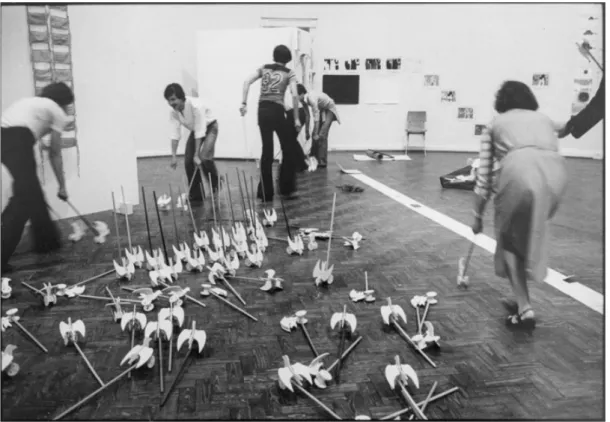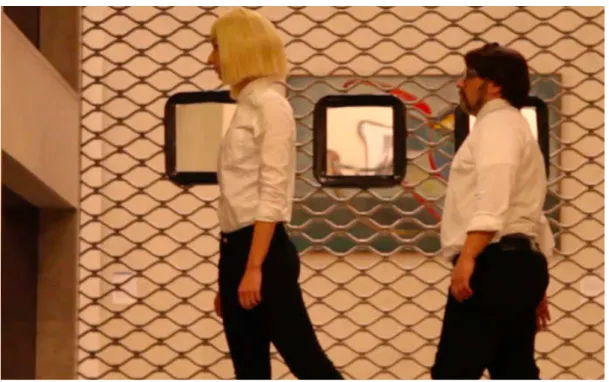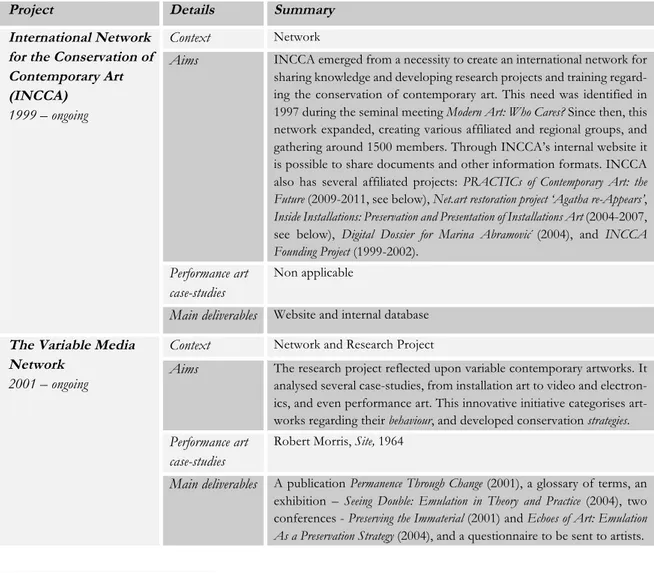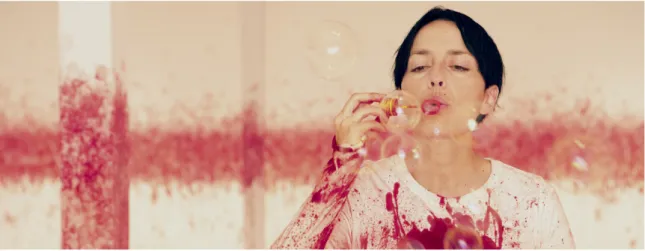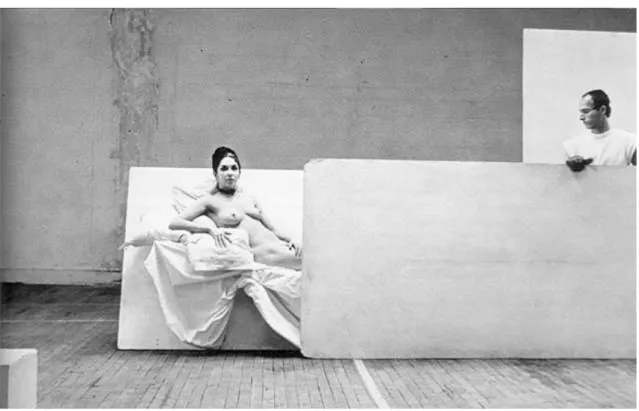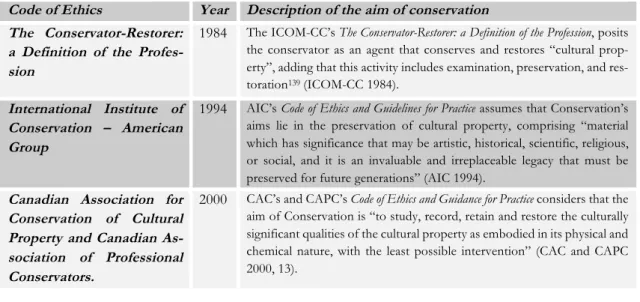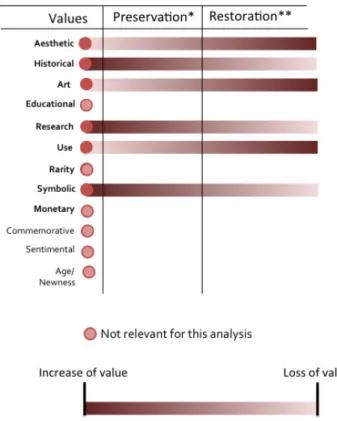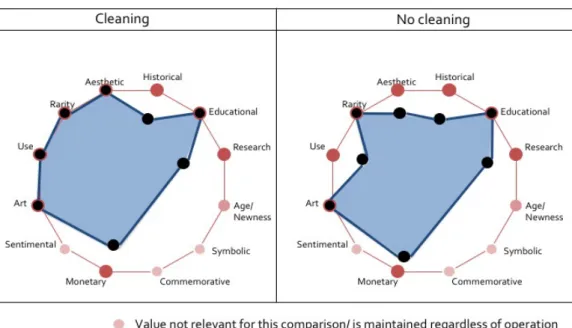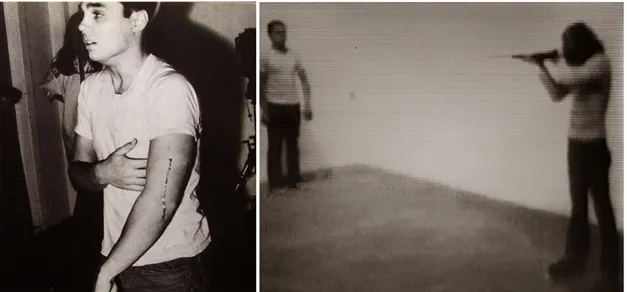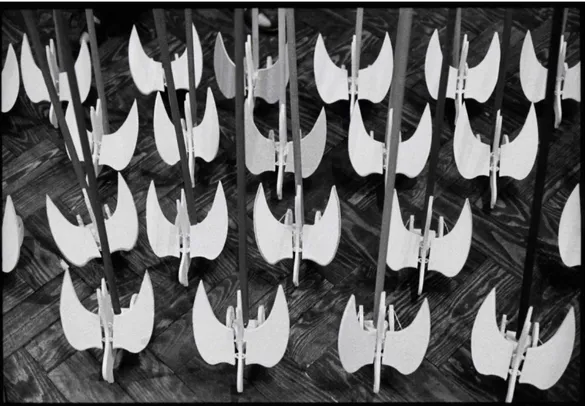Hélia Pereira Marçal
Mestre em Conservação e Restauro
From intangibility to materiality and
back again: preserving Portuguese
performance artworks from the 1970s
Dissertação para obtenção do Grau de Doutor em Conservação e Restauro do Património
Orientador: Rita Andreia Silva Pinto de Macedo,
Professora Auxiliar no Departamento de Conservação e
Restauro (FCT-UNL) e Investigadora Integrada no
Instituto de História da Arte (FCSH-UNL)
Júri:
Presidente: Prof. Doutora Maria Luísa Dias de Carvalho de Sousa Leonardo
Arguente(s): Prof. Doutora Maria Renata Franco Peters Prof. Doutora Laura Lucinda de Oliveira Castro
Vogais: Prof. Doutora Leslie Anne Carlyle
Prof. Doutora Ana Alexandra Rodrigues Carvalho
From intangibility to materiality and back again: preserving Portuguese performance art-works from the 1970s
To Afonso
To Marcos
Acknowledgements
Writing this dissertation was the most frustrating and cathartic process in my academic life so far. The present document is a testament of a valuable learning process, always partial and liminar. In this process I was not alone.
First and foremost, I present sincere thanks to my supervisors, Dr Rita Macedo (FCT-UNL and IHA), for the precious advice, support and inspiration she has given me. I also have to thank Dr Vivian van Saaze, whose advice and support during my time at Maastricht University changed the ways I was thinking about this theme and this dissertation. My time at Maastricht University was of utmost importance for the development of this work, and for that I have to thank to Prof. Dr Renée van de Vall, Dr Louis van den Hengel, and Dr Christoph Rausch, for the important discussions, and to Dr Annet Dekker for allowing me to participate in the documentation of JODI, which highlighted some issues that were unknown to me at that time. Thank you to Dr Jonathan Kemp for the revision of the present manuscript and to the Advisory Committee, Prof. Dr Renée van de Vall – Maastricht University, and Dr Leslie Carlyle – FCT-UNL for their extensive time reading this work and the invaluable comments they made in the final writing stages. In this sense, I have also to thank the anonymous reviewers that critically read submitted articles, which now encompass early versions of excerpts of the present manuscript.
This work would not be possible without the availability of all the interviewees: Vasco Araújo, Ana Borralho e João Galante, Cildo Meireles, Carlos Nogueira, Manoel Barbosa, Vânia Rovisco, Isabel Alves, Ana Candeias, and Raquel Henriques da Silva. I have also to thank Vasco Araújo, Carlos Nogueira, Manoel Barbosa, Vânia Rovisco, and Isabel Alves for the photographic credits and for allowing me into their homes or studios (or sometimes both), showing me their per-sonal archives, and welcoming me in ways that did not go unnoticed. Thank you also to Centro de Artes Plásticas de Coimbra (CAPC), to Fundação Calouste Gulbenkian (FCG), and to Fundação Serralves for the availability these institutions have shown every time I contacted them or consulted their archives and libraries. To the ICOM-CC team for all the insights provided in every meeting, and to ICON for awarding this dissertation with the Taylor & Francis and ICON 2017 prize.
I am also the most thankful to all the people who contributed to making this dissertation
that I should apply to become the Coordinator of ICOM-CC’s Theory and History of Conservation Working Group, and helping me when I did; to Louise Lawson, Anna Buelow, Emily Williams, Re-nata Peters, Joan Reifsnyder, and Kate Seymour for all the support they provided in the last months of finishing this dissertation; to Gunnar Heindereich, Julia Giebeler, and Andrea Sartorius, for invit-ing me to be part of the Workshop on the Decision-makinvit-ing model for the Conservation of Contem-porary Art; to Brian Castriota for all the talks and discussions; to Joana Lia Ferreira and José António Pereira da Silva for all the comments provided; to Isabel Costa for all the support; to Merete Sanderhoff for showing me new perspectives regarding colonial heritage in Denmark; to Cristina Oliveira and Sofia Gomes, for the conversations over coffee; to Ana Maria Ramos for all that she does every day; to Ana Paula Louro, for being available to talk and discuss new ideas.
To my colleagues and friends Alexandra Rodrigues, Ana Bigotte Vieira, Andreia Machado, Francisca Pulido Valente, Inês Coutinho, Juliana Remy de Oliveira, for the solidarity. To Bruno Sam-paio and Vasco Cachatra, may the force be with us.
To my colleagues at the Institute for Contemporary History (IHC), for all the support during the last year of finishing this dissertation. And to Pedro Aires Oliveira for the opportunity.
My deepest thanks go to my beloved friends and family, for their love, understanding and support. Thank you to Marcos for making me believe all was possible and for showing me how to love, and to Afonso, my greatest companion, for teaching me all about resilience and kindness, for
Abstract
Performance art has seen growing incorporation in museum collections in the last decade, and yet Conservation is still struggling to find methods to conserve these artworks, which resist acts of con-tainement. In the context of the present research, three problems hampering progress in the conser-vation of performance art were identified: (1) Conserconser-vation’s scope is often seen in opposition to the nature of performance artworks, (2) there is a lack of an epistemological analysis of Conservation’s documentation methodologies, and (3) there are difficulties in managing the artwork’s networks in institutional contexts. The third problem is beyond the scope of this thesis, as this project was un-dertaken outside an institutional setting. This thesis therefore sheds light on the first two issues by drawing on agential realism (Karen Barad 2007), an epistemological lens which considers that every act of knowing implies material and discursive entanglements within every agent involved.
To answer the first problem, a relational ontology of Conservation, which considers that Conservation practice, instead of being associated only with tangible objects, constitutes and is co- constituted by material-discursive practices, is proposed. Following this reasoning the act of conser- vation is then presented as a set of decisions, which vary in scale and produce materialisations of artistic manifestations. This thesis argues that cultural heritage works, including performance art, are thus always intangible until being materialised by heritage practices, which are characterised by spe-cific ways of seeing, or measurements. In this sense it will be demonstrated that performance art, instead of existing only in the present, exists in various material ways, which are recursively dissemi-nated over time through practices of memorialisation.
To understand the second problem, two performance artworks created in the 1970s by Por-tuguese artists have been documented for the first time in this thesis. The case study analyses demon- strate how current methodologies are focused on perfomance-based art’s materials instead of its ma- teriality and how that process increases the number of exclusions in the documentation process. Exclusions are then explained as acts of affirmation of the dominant cultural and political discourse and, in that sense, contribute to the invisibility of counter-narratives which not only co-constitute but are an intentional part of the fabric of performance artworks. Aside from implying a constant delim- itation in the materialisation of these works, exclusions also immortalise social injustices in the form of, for example, community misrecognition. Participation, understood in the broad sense as an act of yielding authority, is proposed as a way to materialise performance artworks while reducing the exclusions that occur in every documentation process. This thesis argues that a dislocation of author- ity to peripheral stakeholders is not a loss of authorial power, but a way to multiply the instances of the work in multiple body-archives. An outcome of this dissertation, is a proposal and detailed outline for an innovative methodology for documenting performance art works.
Resumo
Com o acentuado crescimento da incorporação de arte da performance em coleções museológicas
nas últimas décadas, a Conservação tem-se debruçado sobre a tradicional oposição deste género
ar-tístico à sua perpetuação no tempo, sem ter conseguido, contudo, ultrapassar as contingências colo-cadas à deslocação da perfomance para o contexto museológico. Na presente dissertação, foram identificados três desafios à preservação da performance: (1) a oposição ontológica entre conservação e arte da performance; (2) a falta de uma abordagem epistemológica aos processos de documentação; (3) as dificuldades inerentes à gestão das redes intra-agenciais que se formam em contextos
instituci-onais. Tendo sido realizada fora de um contexto institucional, esta dissertação foca-se nos primeiros dois desafios através da lente do realismo agencial (Barad 2007), que considera que qualquer processo
de conhecimento implica mudanças materiais e discursivas em todos os agentes.
De forma a responder ao primeiro desafio, propõe-se uma ontologia relacional da conservação, que implica um deslocamento do foco nos aspectos tangíveis do património para uma compreensão da Conservação como uma prática material-discursiva. Neste sentido, propõe-se olhar o acto de conser-var como um conjunto de decisões, que conser-variam em escala e produzem objetos culturais e as suas manifestações. Os objetos são, portanto, intangíveis ate serem materializados por práticas materiais e discursivas de memorialização, que são, por sua vez, caracterizadas por maneiras de ver (ou medir) o objeto. Nesse sentido, as obras de performance, em vez de existirem só no presente, manifestam-se de formas diversas, que são recursivamente dismanifestam-seminadas no tempo.
Para investigar o segundo desafio, foi efectuada a documentação de duas obras de arte da perfor-mance, criadas nos anos 70 em Portugal. A análise dos casos de estudo demonstrou que o foco nos materiais da arte da performance implica um aumento dos aspectos excluídos do processo de docu-mentação. Essas exclusões caracterizam-se como atos de afirmação de discursos dominantes, contri-buindo para a invisibilidade de narrativas alternativas, que não só constituem, mas são parte
funda-mental do tecido destas obras. Estas exclusões também contribuem para imortalizar injustiças sociais,
nomeadamente resultantes da falta de reconhecimento de comunidades envolvidas. A participação de comunidades no processo de documentação, entendida no sentido lato de cedência de autoridade de agentes dominantes, é proposta como forma de materializar a arte da performance, reduzindo as exclusões do processo. Argumenta-se que a cedência da autoridade dos agentes ao centro, aos con-siderados periféricos, não significa a perda de autoridade do artista ou do conservador, sendo antes uma forma de multiplicar as instâncias de corpos-arquivo que efetivamente conservam a performance para gerações futuras. Assim, um dos resultados desta investigação é a proposta de um novo paradi-gma e metodologia para a conservação de obras de arte da performance.
Contents
List of Figures xv
List of Tables xvii
P
ARTI
–
I
NTRODUCTION1
CHAPTER 1 Frameworks, definitions and ambiguities 3
1.1. Aims and Scope 5
1.2. Agential Realism and Ethico-onto-epistemo-logical approach 9
1.2.1. Ethico-onto-epistemo-logical approach 12
1.3. Reading diffractively: approaching the conservation of performance art 14
1.3.1. Case-studies 16
1.3.2. Methodology for case-study analysis 18
1.4. Genealogies and terminology 20
1.5. Outline of the Thesis 22
CHAPTER 2 Conservation in the age of performance 27
2.1. Brief remarks on the evolution of key-concepts in Conservation 28
2.1.1. Revisiting Conservation axioms 30
2.1.2. Reversibility and minimum intervention 32
2.1.3. Value-led Conservation 33
2.2. The Conservation of Contemporary Art: challenges and possibilities 35
2.3. Documentation of performance-based art 43
2.3.1. Unknown unknowns in documentation 44
2.3.2. Collaboration in the Conservation of Contemporary Art: from artists to social networks 47
2.4. Conserving performance art 50
2.4.1. The Variable Media Network 50
2.4.2. Collecting the Performative 53
2.4.3. Main publications concerning the conservation of performance art 54 2.4.4. Conservation of Performance Art: what about now? 56
P
ARTII
-
T
HEORY59
CHAPTER 3 Conservation: from tangibility to materiality 61
3.1. Material-oriented conservation and the notion of tangibility 62
3.2. Cultural Heritage values 64
3.3. Cultural heritage: conserving the object and its values 71
3.4. Intangible Cultural Heritage 74
3.4.1. Intangible tangible Cultural Heritage 74
3.4.2. Rethinking notions of authenticity and safeguarding in Conservation 76
3.5. From tangibility to intangibility: consequences for conservation decision-making 79
3.5.1. Conservation as a material-discursive practice 81
CHAPTER 4 Performance art: looking at materiality from afar? 83
4.1.1. Performance Studies: emergence and continuity 87 4.1.2. Performance art and the after-the-fact 88
4.1.3. From documents to re-enactments 91
4.2. Actualising performance, re-enacting, or materialising Others 93
4.2.1. The body-archive who enacts 97
4.3. Others as Others 98
P
ARTIII
-
M
ETHOD101
CHAPTER 5 Flying doves, paper bouquets, painted skies: artworks by Carlos Nogueira 103
5.1. Before documentation began… 104
5.2. Archival Research 106
5.3. Interviewing Nogueira 117
5.3.1. the dovecote’s exhibitions 119
5.3.2. On the permanence of change: the many lives of Nogueira’s works 122
5.4. Documentation of Nogueira’s works 126
CHAPTER 6 Further into the process: inclusions and exclusions in the dovecote’s documentation 131
6.1. Agential cuts 132
6.1.1. Decisions in the artist’s interview 133
6.1.2. Micro-decisions in the documentation file 136
6.2. Acknowledging stakeholders: beyond the authorised heritage discourse and toward Barad’s
ethico-onto-epistemo-logical approach 138
6.3. Experts and authorised heritage discourse 140
6.4. Parity of participation: conservation in the public sphere 142
6.4.1. Participation as “ceding some or all authorial control” 144
6.4.2. the dovecote’s communities 146
CHAPTER 7 Manoel Barbosa’s catharsis of liberation in Identificacíon (1975) 149
7.1. Before documentation began… 150
7.2. Identificacíon workshop and final presentation 151
7.2.1. Identificacíon’s score 152
7.2.2. Beyond the score: matters outside the plan 156
7.3. Interviewing Manoel Barbosa 159
7.4. Vânia Rovisco and REACTING TO TIME: Portuguese in Performance 162
7.4.1. REACTING TO TIME overview 163
7.4.2. Reacting to Identificacíon 164
7.5. Documentation results: Othering Identificacíon 167
7.5.1. Transmission through bodily practice 168
7.5.2. Practices of documentation / documentation of practices 170
7.5.3. On authorship and delegation 172
7.5.4. All that is absent, all that is lost 173
7.6. Conserving performance art diffractively 175
CHAPTER 8 Discussion and further remarks 179
8.1. Future Research 183
Works cited 185
Interviews 204
A
PPENDIX205
APPENDIX 1Case-studies: brief overview and context relevance 207
Swinging moods: performance art in Portugal 208
Historicization efforts: from the artistic community to academia 209
The institutionalisation of performance art in Portugal: practices of preservation between the
museum, theatre and the university 210
Portuguese performance art in the new millenium 215
APPENDIX 2Portuguese performance art selected chronologies 219
Manoel Barbosa – Cronologia Essencial (1985) 219
Cláudia Madeira – O Híbrido nas Artes Performativas em Portugal (2007) 223 Mariana Brandão – Passos em volta Performance versus Dança: Um cenário concetual e artístico
para o contexto português (2017) 224
APPENDIX 3 Methodological aspects 225
Content Analysis 225
List of Figures
Figure 1.1. the dovecote (1973). Photo by Galvão Teles. Courtesy of the artist. ... 20
Figure 2.1: Maria José Arjona, Untitled (Part of the White Series), 2009 (detail). Performance Documented by: Ted Hartshorn Installation view: Haus der Kulturen der Welt, Berlin, Germany. Courtesy of the artist. Image available at the Museo de Arte Móderna de Bogotá’s Website at https://www.mambogota.com/en/exposicion/hay-que-saberse-infinito/ (accessed in 12/08/2018). . 45
Figure 2.2: Robert Morris, Site (1964). Robert Morris and Carolee Schneemann rehearsing Site. Photo by Hans Namuth. Image available at the Variable Media Network Website at
http://www.variablemedia.net/e/case_morri_site_b.html (accessed in 12/10/2017). ... 52 Figure 3.1: Figure representing the increase and decrease of relative values of a given cultural heritage item
(stained-glass windows) in two different situations: *preservation of the existing state, and **restoration, in this case defined as the cleaning of corrosion crusts. This figure represents a hypothetical example from only one perspective, and the values used relate to those in Alois Reigl’s system. ... 68
Figure 3.2: Scheme developed for this dissertation showing the relative importance of a given set of values, and how an operation (cleaning of hypothetical stained-glass windows) could enhance or minimise different values. ... 70
Figure 4.1: Chris Burden, Shoot, November 19th, 1971 (Santa Ana, California, Gallery “F Space”). Photo documentation on the left, video still on the right. ... 90
Figure 5.1: Carlos Nogueira, the dovecote (1978). A set of wooden doves fills the gallery’s floor. Courtesy of the artist. Photo by Galvão Teles. ... 108
Figure 5.2: Carlos Nogueira, the dovecote (1978). Detail of the dove’s constitution. This picture shows that the doves’ wheels are attached to their wings. Courtesy of the artist. Photo by Galvão Teles. ... 108
Figure 5.3: Carlos Nogueira, the dovecote (1978). First page of the dovecote’s plan. Courtesy of the artist. Photo by Paulo Costa. ... 109
Figure 5.4: Carlos Nogueira, the dovecote (1978). This picture shows some audience members interacting with the doves. Courtesy of the artist. Photo by Galvão Teles. ... 110
Figure 5.5: Carlos Nogueira, the dovecote (1978). This picture shows some audience members interacting with the doves. Courtesy of the artist. Photo by Galvão Teles. ... 110
Figure 5.6: Carlos Nogueira, the dovecote (1978). Page of the dovecote’s plan. Courtesy of the artist. Photo by Paulo Costa. ... 111
Figure 5.7: Carlos Nogueira, the dovecote (1978). Page of the dovecote’s plan. Courtesy of the artist. Photo by Paulo Costa. ... 112
Figure 5.8: Carlos Nogueira, the grey days (1979). Detail showing remnants of the dovecote. Courtesy of the artist. Photo by Alberto Picco, Pierre Lucas. ... 113
Figure 5.9: Carlos Nogueira, the dovecote (1978). Image showing a set of doves in profile. This image is available in Nogueira’s 2012 exhibition Catalogue (Rosendo (ed.) 2012, 252). Courtesy of the artist. ... 117
Figures 5.10 and 5.11: Carlos Nogueira, the dovecote (1978). Detail of the painted wooden doves. Photo by author unknown. Courtesy of the artist. ... 119
Figure 7.1: Reacting to Time. Poster featuring the several Transmission Workshops (2015). Courtesy of the artist Vânia Rovisco. ... 150
Figure 7.2: Detail from the first page of Identificacíon’s score. Courtesy of the artist Manoel Barbosa. ... 152
Figure 7.3: Identificacíon’s score’s second page. Courtesy of the artist Manoel Barbosa. ... 153
Figure 7.4: Vânia Rovisco performs the standard mechanical gesture while being watched by the artist Manoel Barbosa (2014). Courtesy of the artist Vânia Rovisco. ... 153
Figure 7.5: Third page of Identificacíon’s score, featuring an act of confrontation between A and B (highlighted with the orange box). Picture depicting the act, during the final presentation of Workshop Transmissão II. Photo by unknown photographer. Courtesy of the artist Vânia Rovisco. ... 154
Figure 7.6: A performer does the head-turning movement, during the final presentation of Workshop Transmissão I. Courtesy of the artist Vânia Rovisco. Photo by Malia Poppe. ... 155
Figure 7.7: Rods of Aluminium foil, used to purposely fail in breaking the mirrors. Courtesy of the artist Vânia Rovisco. ... 155
Figure 7.8: Set of participants in the final presentation of Workshop Transmissão I. This picture also provides a good perspective of the gallery’s lobby. Courtesy of the artist Vânia Rovisco. Photo by Malia Poppe. ... 158
Figure 7.9: Picture of the Atelier from FASVS’s Museum, where rehearsals from Workshop Transmissão I occurred. Courtesy of the artist Vânia Rovisco. ... 158
Figure 7.10: Composition showing pictures of the five different renditions of Identificacíon through Rovisco’s process. (1) Lisboa, Portugal; (2) Guimarães, Portugal; (3) Torres Vedras, Portugal; (4) Blanca, Spain; (5) Porto, Portugal. Courtesy of the artist Vânia Rovisco. ... 165
List of Tables
Table 2.1: Brief description of projects and networks related to the conservation of performance-based art . 36
Table 3.1: Description of the aim of Conservation in selected Codes of Ethics and Definitions of the practice.63
Table 5.1: Designation and description of the documentation fields used (including sub-fields). Application to the dovecote will be explored wherever relevant. As noted, this documentation was carried out in the accepted conservation format as an exercise to reveal how the current methodology falls short (see Chapter 6). Chapter 7 and the Appendix 3 add new ways of documenting performance art, which are a result of this dissertation. ... 126
Table A3.1: Dimensions for artist’s interviews applied to the documentation of Manoel Barbosa’s Identificacíon ... 228
A memória e o seu registo – a revolução que nesses termos se pode ler, inevitável,
tanto quanto nas derrotas políticas. No futuro. Lá estarás com o teu olhar límpido.
Utopia.
Ernesto de Sousa, “To perform” (excerpt), Opção, n.º 101 3 de Março de 1978
Memory and its recordings – within these terms we can inevitably read both revolution and polit-ical defeats. In the future. You will be there with your unblemished way of seeing. Utopia.
CHAPTER 1
Frameworks, definitions and ambiguities
A paradox: the same century invented History and Photography. But History is a memory fabricated according to positive formulas, a pure intellectual discourse which abolishes mythic Time; and the Photograph is a certain but fugitive testimony; so that everything, today, prepares our race for this impotence: to be no longer able to conceive duration, affectively or symbolically: the age of the Photograph is also the age of revolutions, contestations, assassinations, explosions, in short, of impatience, of everything which denies ripening. Roland Barthes1
To be mortal is the most basic human experience, and yet man has never been able to accept it, grasp it, and behave accordingly. M an doesn ’t know how to be mortal. And when he dies, he doesn’t even know how to be dead. M ilan Kundera2
Conservation as a discipline has been concerned with immortality since its early days.3 Strategies for “safeguarding tangible cultural heritage” (ICOM-CC 2008), delaying or preventing its disappearance, are traditionally allied to the maintenance of the original material features of the artwork.4 With the advent of Contemporary Art and its incorporation into museum collections, the frontiers of antithet-ical relationships such as mortality5 and immortality,6 or materiality and immateriality, became less sharp. While a 19th-century painting was meant to last, contemporary artworks, created with precarious ma-terials and often through experimental techniques, challenged traditional ambitions for art preserva-tion (Beerkens 2016). An artwork’s rapid ephemerality was often an unpredictable consequence of
1 In Roland Barthes, Camera Lucida: Reflections on Photography (Hill and Wang; Reprint edition 2010 [1980]), 26. 2 In Milan Kundera, Immortality (Harper Perennial Modern Classics; 1st (first) edition (1999) [1990]).
3 In the context of this dissertation the term “conservation” might appear capitalised or not. When capitalised, it refers to
the field/discipline of Conservation. When in lowercase, it implies a broad notion of conservation as an overarching goal of transmitting something to present and future generations. In this sense, conservation in the broad sense is not restricted to the Conservation discipline but regards an intention or a will to preserve that occurs across various disciplines. The same also happens with associated disciplines, as in the case of the Conservation of Contemporary Art that refers to the field when capitalised, and to the overarching goal of conserving contemporary art when in lowercase. The conservation of performance art, because is still not regarded as a field of study, will appear in lowercase.
4 Conservator Jonathan Kemp, for example, states in Practical Ethics v2.0: “there is a pronounced instability in identifying
particular components as sites of authenticity in the sense of ‘original material,’ traditionally one aspect of an object charged by the assignation of a ‘truth-value’ that legitimizes some aesthetic experiences.” (2009, 60-1).
5 Italics will be used throughout this dissertation in order to emphasize certain keywords or to name titles of artworks,
articles or books.
the use of modern materials (such as polymeric materials) or alternative techniques.7 Through the 20th-century, artists’ attitudes regarding their artworks’ deterioration changed: what once was thought to be catastrophic became something some artists desired.8 The trend towards dematerialisation (see Lippard 1973) took on several forms, crossing various art genres from conceptual to installation and other types of time-based media art.9 Many art genres considered to be included in time-based media art led to new understandings and experiences of time, history, memory, or identity. Performance art, for example, by activating time through movement and action, by operating bodies as art materials and, it turn, reconfiguring expectations about the use and value of bodily experience, can be consid-ered one of the most volatile, precarious,10 and dematerialised art genres.11 In artworks intended to dematerialise, their purpose became fulfilled through their ultimate loss, and Conservation’s tradi-tional canons and strategies were deemed inadequate (cf. Wharton 2005, Wharton and Molotch 2009, Beerkens 2016). In the last twenty years (cf. Beerkens 2016), studies in the Conservation of Contem-porary Art have flourished worldwide to challenge Conservation theories beyond the realm of Con-temporary Art.12
The present dissertation draws on the context of the Conservation of Contemporary Art to address the preservation of performance art. Performance art has been considered at the intersection between visual arts and the performative. Art historian Amelia Jones defines performative as something that can be “loosely understood (…) as the reiterative enactment across time of meaning (…) through
embodied gestures, language, and/or other modes of signification” (2012, 12). Artworks that share with performance art this event-like execution are, by association, called performance-based artworks (cf. Laurenson and van Saaze 2014).13 The ephemerality that characterises this artistic medium is the ultimate challenge to any ambition in Conservation to immortalise cultural heritage.14 According to
7 The book Mortality Immortality?: The Legacy of 20th-Century Art (Corzo (ed.) 1999) presents some examples of the use of
modern materials and alternative techniques.
8 See examples in (Chiantore and Rava 2013) and (Ferriani and Pugliese 2013)
9 Time-based media works have a variable nature, changing and evolving with time. Variations can be seen as a foil to
develop new ways of experiencing these artworks across time and space. Other terms related to this art genre emerge in the relevant literature, such as media art (namely in projects whose lineage is mostly related to archival sciences), multimedia art
(see Hanna Hölling’s work – 2017, for example), or electronic media art (terminology used by the America Institute of Con-servation, for example).
10 The use of the term precarious was informed by Eleonora Fabião’s “Precarious, Precarious, Precarious. Performative
Historiography and the Energetics of the Paradox: Arthur Bispo Do Rosario’s and Lygia Clark’s Works in Rio de Janeiro” (New York University, 2006). See also Fabião (2012).
11 The association between performance art and immateriality has since been contested. See Chapter 4 for more details. 12 Scholarly efforts emerging in the field of the Conservation of Contemporary Art can be traced back to the 1990s, with
the development of the Artist’s Documentation Program, by the conservator Carol Mancusi-Ungaro. See Chapter 2 for more details. It is also important to note that this was not the first time that qualitative methodologies of inquiry were used in the field of Conservation. Paintings conservator Joyce Hill Stoner started performing interviews to renowned conserva-tors back in the 1970s in the framework of the Oral History Project, which aims to record the memory of Conservation professionals around the World (see the Project’s page at www.conservation-us.org/our-organizations/foundation-(faic)/initiatives/oral-history-project#.W2QvGVVKiUk).
13 For more on how installation art’s and performance art’s ontologies sometimes overlap see (Irvin 2013).
14 This genre has been characterised by its ephemeral and event-like nature, which has been intrinsically linked to the context
Performance Studies theorist Peggy Phelan, performance artworks cannot be reproduced or fully represented, as they disappear after their materialisation (Phelan 1993, 146). And yet, somehow they seem to keep coming back to life. Documents, material remains, gestures, voices, or acts of remem-brance, either individual or collective, bring to life, or at least evoke, these once dead artworks. So are they ever really gone? Looking at Milan Kundera’s thoughts about death and immortality, as cited in this chapter’s epigraph, it seems that performance artworks, inasmuch as man, do not “know how to be dead”.15 How can Conservation cope with these works that, after the initial spurt of life, persist in limbo, being neither alive nor dead? How can Conservation deal with works that no longer exist and, yet, keep getting evoked? Can performance art in its messiness and intended variability, ever be immortalised or even transmitted? Can Conservation shift its emphasis and incorporate preserving variable materialities?
1.1.
Aims and Scope
This research project aims to understand how performance art is changed by Conservation’s ways of knowing and how, in turn, Conservation is changed by performance art’s idiosyncratic para-doxes. Given the wide scope of what can be considered conservation activities, the present disserta-tion is focused on documentadisserta-tion processes.16
The emphasis on performance art documentation instead of performance art ontology rep-resents a theoretical shift from what constitutes performance to “how we do things with perfor-mance”, as suggested by art historian Jonah Westerman (Westerman 2018, 2). Through the analysis of documentation practices, some inferences about performance artworks can be developed. Refer-ring to performance art documentation and institutionalisation, Westerman continues:
First, it becomes clear how indivisible are any given performance and its documentation. It might be ordinary now to question the seemingly straightforward temporal sequence whereby action necessarily precedes concerns about registration (…). A focus on practices, however, reveals the extent to which these complex interrelations are the effects (not the causes) of how performances
the several factors that might have contributed to the emergence of this medium, four aspects seem to be particularly underlined in the relevant literature: (1) the growing tendency towards the dematerialisation of the art object (see Lippard 1973), (2) the expansion of the notion of art as movement or action, which can be traced back to Pollock’s action-painting
(see Kaprow 1993 [1958]), (3) the use of the body as instrument (see Jones 2012b), or (4) the socio-political context, linking the occurrence of performance art to a reaction against the art market, commodification and capitalism (Goldberg 2001; Bishop 2012). More information about performance art and its emergence can be found in Chapter 4.
15 Regarding performance art re-enactments, art historian and theorist Hal Foster (2015) raises a very relevant point, which
also details how these artistic manifestations are often characterised by their hybrid and liminal existences: “Not quite live, not quite dead, these re-enactments have introduced a zombie time into these institutions. Sometimes this hybrid tempo-rality, neither present nor past, takes on a gray tonality, not unlike that of the old photographs on which the re-enactments are often based, and like these photos the events seem both real and unreal, documentary and fictive” (Foster 2015, 127).
16 Such a view is resonating closely with Vivian van Saaze’s idea of the artwork’s authenticity and ontology as something
construct and provoke particular kinds of relations between audiences and artworks in actual con-texts of encounter and reception (…). Second (…), it becomes readily apparent that what we sometimes consider the existential contest between the experimental practice and the ‘museum’ (…) is largely fantastical. (…) performance and ‘the institution’ are dynamically co-determining – in much the same way as performance and documentation – and have been for quite some time. (Westerman 2018, 2).
The research presented here aims to address a knowledge gap that persists in regard to the conservation of performance art and, more specifically, documentation.17 While the conservation of Time-based Media Art, a field that also encompasses performance-based works, has been addressed in recent years, efforts towards the conservation of performance art are still somewhat tentative. The few Conservation studies related to performance art are usually directed to identifying problems re-garding performance artworks’ preservation. Tate Galleries’ Head of Collection Care Research, Pip Laurenson, and Maastricht’s University Scholar, Vivian van Saaze, identified three challenges for the conservation of performance art in an essay addressing the results of one of the few studies focussed on the issue. They found that, (1) performance art’s authenticity tends to be connected to the original event and the presence of the performer, (2) there is an opposition between Conservation and performance art: while Conservation is traditionally attached to object-based art practices, primarily established at a material level, performance art is often deemed immaterial, and, finally they recognised (3) the contingencies of maintaining the artwork’s social networks at an institutional level (Laurenson and van Saaze 2014). At the same time, the notion of documentation is broadly used throughout different disciplinary contexts. Indeed, in the same book that Westerman puts forward the idea of thinking about performance art through documentation practices, authors from various disciplinary fields reflect upon the idea of documentation and documents using the same terms to discuss diverse methodologies and practices, throughout various fields of knowledge including Con-servation, Visual Studies, Performance Studies, or Art History.18 The need for a redefinition of Con-servation methodologies in regard to Contemporary Art and its terminology to embrace performance art’s idiosyncrasies was an evident conclusion of the few other research projects that studied this artistic manifestation.19 At the same time, although documentation production, a methodology commonly used in the Conservation of Contemporary Art, is still considered the best possible way to allow for the revival of these artworks, the pitfalls of this approach are starting to be identified, namely its inability to rescue performance art’s main characteristic: its (a)liveness. Documentation
17 During the last days of writing up this thesis in February 2018, Tate (London) has announced that they had been awarded
$1.5 million from The Andrew W. Mellon Foundation for developing new models “for the conservation and management of recent and contemporary works of art (…) such as time-based media, performative, live and digital art.” (Sharpe 2018). This award also helps contextualise the relevance of the present project.
18 That is the case, for example, of Pip Laurenson, who discusses the use of documentation as a conservation method, and
other authors such as Henry Lowood, Eric Kaltman, and Joseph C. Osborn who reflect upon “documentation” as video recording (see Westerman and Giannachi (eds.) 2018).
19 Having been typically developed by museums in collaboration with academia, such research projects are mostly focused
made in the context of museums and other heritage institutions often allows performance works to be shown in other contexts, however, as it will be made clear in this dissertation, the works that are collected usually belong to a category (“delegated-performances”) which already implies the existence of a simple script to be followed by others. Whenever that its not the case, the continuous quest to secure art’s immortality has frustrated most possibilities for keeping performance art alive beyond its documentation.
Through a detailed analysis of relevant literature in the field of Conservation (more details in Chapter 2 of this thesis), three issues hampering progress in this research can be identified:
(1) Conservation’s scope versus the immateriality of performance artworks. (2) Lack of an epistemological analysis of documentation methodologies. (3) Difficulties in managing the artwork’s network of social connections
These issues could be translated as theoretical, methodological, and practical. Given the goal of this dissertation – to understand how conservation and documentation practices are affected by perfor-mance art and how perforperfor-mance artworks can change through the conservation process, its aim is
methodological. It is not feasible, however, to tackle methodological issues without addressing current theoretical frameworks. In the same sense, it is not possible to aim at answering any institutional concerns without addressing the lack of methodological reflection. Given the breadth of the issue and a necessarily sequential approach to the problems of conserving performance art, this thesis will
focus on discussing the first two domains: the theoretical and the methodological. The need to ex-plore these two issues has consequences for the structure of the thesis: while the first part of the text carries out a theoretical examination of both Conservation’s and performance art’s ontology, the second part utilises a set of selected case-studies in order to examine processes involved in perfor-mance art documentation. Art historian Jonah Westerman tells us that perforperfor-mance art and its doc-umentation are co-determining (Westerman 2018). In this sense, the focus on the docdoc-umentation
process is on a par with understanding performance art’s ontology - which has been the focus of efforts in Performance Studies and Conservation. The present approach therefore mandates what can be called an onto-epistemological approach to the problem of the conservation of performance art. As the ephemerality of performance art puts it somewhere between the material and the imma-terial, an analysis of the medium needs to acknowledge its liminality. Conservation, on the other hand, ranges between the preservation of tangible objects and their intangible values and discourse, which also implies a sense of the in-betweenness of what an object is, what it was, and what it can be. This paradox is characterised by the immediacy of being in the present whilst simultaneously thinking about how that immediacy, that being in the present, can be transmitted to the future. Reflection upon both Conservation and performance art thus demands an interrogation of those otherwise strict dichotomies: mortality and immortality, tangible and intangible, material and discourse, and materiality and
the exploration about the ways they co-constitute each other, demands an epistemological lens that encompasses the juxtaposition of typically opposing views and the annulment of strict and fixed ontological borders. It demands an approach that asserts performance art’s liminal state along with Conservation’s action, which lies in-between past, present, and future. The performative material-discursive theory of agential realism by philosopher and feminist scholar Karen Barad - (Barad 2003, 2007, 2010, 2011, 2012) - with its “ethico-onto-epistemo-logical” commitment, is one such approach.
Barad’s agential realism has been applied to the study of visual artworks by the art historian Amelia Jones (2015). In an article about material traces in performance art, the art historian and theorist Amelia Jones shows how the continued reliance on discourse might have transformed the way we see and experience performance art. Jones suggests that hybrid works, which move between performance and the installation of the performative act’s remains, show the limits of traditional ways of interpretation, “whether art historical or curatorial (…) or based in performance studies’ tendency to emphasize process and narrative content or to claim “authenticity” for the performing live body” (Jones 2015, 20). Referring to Heather Cassils’ Becoming an image performance from 2013, Jones sug-gests that an art historical approach would “dwell on the photographs alone designating Cassils as their intentional, activating agent and reading them as static objects” (Ibid.). Performance Studies, on the other hand, would “tend to discuss the visceral experience of the performative moment of enact-ment (…) as proof of our access to an “authentic” body of action” (Ibid.). Through her analysis of
Cassils’ work, Jones argues for a material-discursive analysis, namely through the theory of agential realism developed by Karen Barad (Barad 2007). Under Jones’ analysis, material-discursive practices emerge as a possible method to effectively engage with an artwork’s present and past materialities.20 Accordingly, looking at the visual arts through the lens of agential realism allows researchers to “at-tend to the animated and animating potential of materialities while also acknowledging the performa-tive aspect of these materialities (i.e., that through their specific manifestations, they promote an
understanding of the previous actions involved in their having been made in the past)” (Jones 2015, 27). Besides allowing for the performativity of visual art as well as its histories, agential realism cancels traditional oppositions such as subject and object, or discourse and matter. At the same time, agential realism can be used to jettison the idea “of the artwork as a fixed endpoint (of making) or as a fixed beginning point (of interpretation)” (Jones 2015, 32). Jones suggest that in this sense, the advantages to using Barad’s theory in the study of visual art seem to compensate for the pitfalls of previous
20 According to Jones, the relationship between artwork and its maker is at the core of any art commodification, being
framed as an “extreme humanist investment in singular agency” (Jones 2015, 26), and thus, challenging new materialist and
theoretical frameworks (see Jones 2015).21 In the same way as Cassils’ installations operate as remains of a past action (or labor), performance art is also materialised as an hybrid between the past action and the memories that emerge in the present time, ever fragmented and materialised in multiple human and non-human bodies.
1.2.
Agential Realism and Ethico-onto-epistemo-logical approach
Using studies in quantum physics (namely Nils Bohr), post-structuralist theories (Michel Foucault and Judith Butler), and Donna Haraway’s feminist influenced studies (and especially her ideas around ‘Situated Knowledges’ – see Haraway 1988), Barad proposes that the world is made up of phenomena that “come to matter” through “the ontological inseparability of intra-acting agencies” (Barad 2007, 139). Intra-action, she proposes, stands “in contrast to the usual “interaction,” which presumes the prior existence of independent entities or relata” (ibid.). Accordingly, intra-actions are what provides meaning to “particular material articulations of the world” (ibid), and what creates objects. Objects and all other phenomena (including performance art) are, as a product of these intra-actions, “con-tingent configurations of mattering” (Barad 2013, 7), which occur between human and non-human agents. In other words, while inter-action, characterised by the prefix inter-, refers necessarily to two distinct entities that undertake an action together, at a given moment, intra-actions imply that those entities are never distinct nor separated nor even pre-existing. Barad suggests that intra-actions reflect a “relational ontology” (Barad 2003, 812), which is at the basis of every interaction in the world whether we are humans or non-humans. In this sense, Karen Barad’s agential realismacknowledges the intertwining between the observer and the object. In order to illustrate how intra-actions occur in the case of artworks, the art historian Amelia Jones, refers to Juliana Cerquiera Leite’s the climb is also the fall (2011) in her essay on performance art’s material traces, and argues that:
I experience [the climb is also the fall] through its materialities the way in which the silicone, the steps, and gravity conspired to limit and define the movements of Leite in composing the imprinted body-work I encounter. Isn’t this co-articulation similar to the way in which my description of this experience here affects my memory of the work, and your access to it, and thus what the work “is” for those who have read these words? All are intra-active. (Jones 2015, 28)
21 New materialist approaches, such as Barad’s agential realism, or Bruno Latour’s Actor-Network Theory (ANT), recognise
The notion of intra-action has repercussions in the way matter is understood. If we are all part of the same entity and performing only intra-actions instead of inter-actions, every act of knowing is entangled with an act of being and becoming. Every act of knowing then transforms both the knower and the known. In Posthumanist Performativity Barad, drawing on Butler’s performativity and Foucault’s historical discursive practices, argues that matter is not fixed and contained, but an on-going prac-tice.22 To Barad, matter “is always already an ongoing historicity” (Barad 2003, 151), and “is substance in its intra-active becoming - not a thing but a doing, a congealing of agency”:
Matter is a stabilizing and destabilizing process of iterative intra-activity. Phenomena - the smallest material units (relational “atoms”) - come to matter through this process of ongoing intra-activity. “Matter” does not refer to an inherent, fixed property of abstract, independently existing objects; rather, “matter” refers to phenomena in their ongoing materialization.
Matter is, therefore, known through any act of observation. Observation implies an act of
measurement, or what Barad calls an “agential cut”. Barad posits:
Measurements are agential practices, which are not simply revelatory but performative: they help constitute and are a constitutive part of what is being measured. In other words, measurements are intra-actions (not interactions): the agencies of observation are inseparable from which is observed. Measurements are world-making: matter and meaning do not preexist, but rather are co-constituted via measurement intra-actions. (Barad 2012, 6)
Agential realism makes visible the inevitable relationship between the ways of knowing a given phenomenon, say a performance artwork, and the determination of what that phenomenon is considered to be, or its measurement. In this sense, and once again drawing from Haraway’s Situated
Knowledges, Barad does not separate measurement from the phenomenon. She does not separate ways
of looking from who is looking and the observed entity. In this sense, both Haraway and Barad refuse the idea of an ‘outsider’s look’. Experiencing looking at something through a microscope might allow us to better understand what Barad is saying.
When we look through the lens of a microscope, for example, agents include the observer, the instrument, and what is being seen. When we make decisions to know (or measure) a specific area instead of another, we are performing an agential cut. When we choose to take a sample from a specific place instead of another, we are performing an agential cut. The idea of measurement and the mutability of matter according to specific measurement instruments is also well understood (and observed) in the field of physics. Barad uses examples of this phenomenon such as electron’s making quantum leaps (Barad 2010), or electron diffraction as embodied by the double-slit experiment (Barad 2007). Barad also points to wave-particle duality and Schrödinger’s cat as other notable examples from physics that express the importance of measurement (Barad 2007, 2010).23
22 This view is shared by other feminist theorists including Elizabeth Grosz (Grosz 2009, 2017) and Donna Haraway (2004
[1992]). See also (Coole and Frost 2010a, 2010b).
23 The importance of observation was addressed in the field of Conservation by Helen Glanville. Glanville, a conservator
Measurements are, within the agential realism framework, intra-actionsinfluenced by appa-ratuses.24 And apparatuses, according to Barad, are phenomena which include structures, mediums, human and non-human, that allow for the measurement of an emergent property. She develops her notion of apparatus by departing from Foucault’s homonymous use of the term, criticising his defi-nition as failing to encompass how apparatus change and are changed by the phenomena they meas-ure.25 This critique is at the core of what makes agential realism a material-discursive approach:
(…) there are crucial features of power-knowledge practices that Foucault does not articulate, including the precise nature of the relationship between discursive practices and material phenom-ena; a dynamic and agential conception of materiality that takes account of the materialization of all bodies (…) (Barad 2007, 200)
In other words, according to Karen Barad’s theory, discourse and matter do not exist as separated entities. Any apparatus transforms the phenomena it observes by the performance of being
observed through that apparatus. As every intra-action is relational and given the proposed performa-tive entanglement of discourse and matter in agential realism, the creation of apparatuses is thus essentially “material-discursive”. For example, the act of reading a text, or hearing a speech, implies an entanglement between discourses (i.e. the text or the speech, as well as all socio-historico-philo-sophical texts that inhabit both the contents and matter of that text or speech) and its materialities (the book or screen that provides the text, body or speaker that speaks). Materials, here, are not a way of mediating a discourse, but are discourses in themselves, in the same way that discourses come into matter. In this sense, and as Barad demonstrates in Meeting the Universe Halfway (Barad 2007), material and discursive practices are mutually entangled but neither has a more privileged status over the other. Agential realism is materially-discursive not only because the production of material beings and their apprehension in the world are concomitant,26 but also because a given apparatus provides the materialisation of a particular possibility, thereby excluding others. The act of reading a text from
nature of light, of matter, or of any phenomenon including the work of art, all of which are organized wholes which are greater than the sum of their parts”.
24 Barad explains that measurements, “including practices such as zooming in or examining something with a probe, don’t
just happen (in the abstract) – they require specific measurement apparatuses (...). If measurement intra-action plays a constitutive role in what is measured, then it matters how something is explored. In fact, this is born out empirically in experiments with matter (and energy): when electrons (or light) are measured using one kind of apparatus, they are waves; if they are measured in a complementary way, they are particles” (Barad 2013, 6).
25 Although Barad critiques Michel Foucault’s approach to historicization and apparatus, the author is deeply influenced by
Foucault’s discourse on power-knowledge relations. Barad focusses on Foucault’s History of Sexuality, trans. Robert Hurley (New York: Vintage Books, 1980), however, there are possible correlations to the issue of the archive detailed by Foucault in The Archaeology of Knowledge and the Discourse on Language. Trans. A. M. Sheridan Smith (New York: Pantheon Books, 1978). The issue and the workings of the archive are not part of this dissertation’s discussion. For more on this subject please see Joan M. Schwartz’s and Terry Cook’s article entitled “Archives, Records, and Power: The Making of Modern Memory” (Archival Science 2, 2002). The power of the archive, along with “its underlying nature, theoretical assumptions, practical applications, historical evolution, and consequences for users” (Schwartz and Cook 2002, 2) is detailed in two special the-matic issues of Archival Science on “Archives, Records, and Power,” published in 2002. See also Carter 2006.
26 Barad argues that “knowing does not require intellection in the humanist sense, either. Rather, knowing is a matter of
a book instead of a screen, in a private library surrounded by old books with leather covers instead of at a crowded square in the city centre, is part of the text’s discourse and materiality. The act of understanding a text, of knowing a text, implies material and discursive transformations in both the text and the reader. Knowing is thus performative, as it implies an utterance, or an act, that does
something in the world (cf. Austin 1962).27 In this sense, knowing is also an ongoing construction of the phenomenon’s existence; being is intertwined with ontology, and vice-versa. Reality, on the other hand, exists in a state of indeterminacy, a virtuality full of possibilities. In other words, if mattering acquires meaning and form through its capacity of realising different possibilities, the future is always undetermined. Karen Barad posits that indeterminacy is “only ever partially resolved in the materialization of phenomena: determinacy, as materially enacted in the very constitution of a phe-nomenon, always entails constitutive exclusions (that which must remain indeterminate)” (Barad 2013, 7). Measurements, or ways of knowing, are then acts of excluding agential possibilities, of per-forming agential cuts. Choosing one possibility instead of others,28 or measuring in a specific way, can be regarded as ethical. In this sense, given that ethics is related to forms of being and knowing, Barad regards agential realismas essentially an ethico-onto-epistemological approach.
1.2.1.
Ethico-onto-epistemo-logical approach
Barad’s ethico-onto-epistemological approach is developed from elements of Donna Hara-way’s feminist theory where “the need for accountable and just knowledge production, the idea that one cannot but ethically engage with the world” is emphasised (Geerts 2016). The act of measuring implies the creation of a given existence, while at the same time erasing other existences. In other words, the particular circumstances surrounding a given act of reading a text have constitutive con-sequences in both matter and discourse, excluding other matter and discourse entanglements that could have existed given other circumstances. The creation of that existence, against all “Others”, therefore, entails a sense of both accountability and responsibility.29 We are accountable for our meas-urements, as we are responsible for discovering how they mis- or un- represent other existences. Barad’s proposal of an “ethics of entanglement” precisely targets an individual’s accountability across
27 The idea of performativity will not be discussed in the context of this dissertation. It emerges from the notion of performa-tive utterances. According to the philosopher James Loxley performative utterances imply that “words do something in the world, something that is not just a matter of generating consequences, like persuading or amusing or alarming an audience.” (Loxley 2007, 2). For more on performative see J. L. Austin’s How to Do Things with Words (Oxford: Clarendon Press, 1962), Judith Butler’s Bodies that Matter. On the Discursive Limits of Sex (London and New York: Routledge, 1993), and James Loxley’s
Performativity (London and New York: Routledge, 2007).
28 There are many other intra-actions influencing a given choice, so no choice is isolated or devoid from its contingencies.
Thank you to Dr Jonathan Kemp for pointing this out during manuscript revision.
29 It is important to mention that the act of reading (or measuring) is not restricted to human agencies, as non-human agents
what she calls “spacetimematter.” Being part of every phenomenon, or being part of its “entangle-ments”, is our debt towards human and non-human Others, and is part of what constitutes phenom-ena:
An ethics of entanglement entails possibilities and obligations for reworking the material effects of the past and the future. There can never be absolute redemption, but spacetimematter can be productively reconfigured, reworking im/possibilities in the process. Changes to the past don’t erase marks on bodies; the sedimenting material effects of these very reconfigurings – memo-ries/re-memberings – are written into the flesh of the world. Our debt to those who are already dead and those who are not yet born cannot be disentangled from who we are. What if we were to recognize that differentiating is a material act that is not about radical separation, but on the contrary, about making connections and commitments? (Barad, 2011, 150)
According to Barad, diffraction30 is a way to accept the ethical responsibility that comes every time we perform agential cuts: “We can understand diffraction patterns – as patterns of difference that make a difference – to be the fundamental constituents that make up the world” (Barad 2007, 72). Evelien Geerts and Iris van der Tuin suggest that Barad uses the metaphor of diffraction “to denote a more critical and difference-attentive mode of consciousness and thought” (Geerts and van der Tuin 2016, n.d.). Geerts and van der Tuin trace the genealogy of the use of the term and suggest that diffraction fulfils the need to “include” the often excluded Other. In discussing Haraway and also Trinh Minh-ha’s perspectives on diffraction, they suggest that as methodology diffraction disturbs heteronormative Western-centric perspectives that populate discourse and readings of matter31:
Thinking diffractively steps out of the phallogocentric, reflective logics of producing the Same all over again by acknowledging the differences that exist, while at the same time pointing at where the problematic reductions and assimilations of difference have taken place (…) Rather than em-ploying a hierarchical methodology that would put different texts, theories, and strands of thought against one another, diffractively engaging with texts and intellectual traditions means that they are dialogically read “through one another” to engender creative, and unexpected outcomes (ibid., 30). And that all while acknowledging and respecting the contextual and theoretical differences between the readings in question. (Geerts and van der Tuin 2016, n.d.)
The possibility of reading “dialogically (…) through one another”, mirrors how transversality and transdisciplinarity (along with other qualities with the prefix trans-) can be seen throughout Barad’s works. Even the notion of intra-action itself reflects (or diffracts) that same idea of cross-sectionality and transversality. Geerts and van der Tuin suggest that Barad proposes to expand intra-action across the disciplinary fields of thought (or, in some sense, the apparatus of epistemology), entangling our ways of seeing and thus create new practices:
Reading diffractively therefore not only appears to transcend the level of critique, ultimately based in a Self/Other identity politics, but in Barad’s regard also can be regarded as a boundary-crossing,
30 Diffraction is a set of physical phenomena that occur each time a wave meets an obstacle. In classical physics it can be
seen as wave interference (Barad 2007, Geerts and van der Tuin 2016, n.d.). In quantum physics, as objects have wave-like qualities, “we are invited to think about the inherent diffractivity of sets of waves, of single waves, and of single particles, under the right (experimental) conditions” (Geerts and van der Tuin 2016, n.d.).
31 They go on to describe how Haraway, in referring to optics, contrasts diffraction with reflection. While reflection creates
trans/disciplinary methodology, as it brings about “respectful engagements with different discipli-nary practices” (Barad 2007, 93). Blurring the boundaries between different disciplines and theories to provoke new thoughts and theories, this methodology examines how and why bound-aries between disciplines and strands of thought have been made and how they can be (re)made to matter more toward inclusion than apartheid. (ibid.).
Following on from this idea of transdisciplinarity, Barad argues in Meeting the Universe Halfway
that agential realism and diffraction might have repercussions for analysis in feminism (reproduction and women’s bodies, for example), literature,32 social inequalities, along with issues related to science studies.33 That is also necessarily true about the application of her ethico-onto-epistemological ap-proach. Because Barad presents a way of studying how things are made observable, its application to the conservation of performance art is worth further exploration.
1.3.
Reading
diffractively
: approaching the conservation of performance art
Barad’s theoretical framework seems to answer the chronic dichotomies found in the
con-servation of performance art. It offers operative notions, such as agential cuts or diffraction, that are essential to critically assess how performance art is understood through the lens of Conservation, and how a process of knowing changes both performance artworks and the conservation process. Barad’s agential cuts, for example, refer to acts of excluding other agential possibilities, i.e. of privileging one way of knowing instead of another. Exclusions, although excluded, are still part of the observed entity. Through the act of knowing (or measuring), exclusions are not taken into account. Drawing on
Barad’s analysis of the use of scientific instrumentation, for example, it is possible to see how scien-tific analysis in Conservation studies ends up co-constituting both the object’s discourse and matter. The act of choosing a given sample instead of others implies excluding a realm of possibilities that could derive from different results. The act of choosing to analyse the object under a specific lens (such as through an XRF device) also delimitates the knowledge obtained to very specific inclusions (or results). In both cases, new knowledge provided by measurements (made by human – the con-servator – and non-human – the XRF device – agents) imply a material and discursive reconfiguring of the artwork. Looking at performance art documentation, the act of recording a performance work, through a specific mediation device, which implies choices regarding viewpoints, what to record, when to stop, what to focus on, also implies a series of inclusions and, consequently, exclusions that reconfigure both the performance artwork and the conservator material-discursively. In the same manner, interviewing an artist might consist of several agential cuts, promoted by the ways of asking a specific question, or even the decision of asking that question instead of another.
32 In line with this approach, Marije Hristova’s PhD thesis, entitled Reimagining Spain: Transnational entanglements and remem-brance of the Spanish civil war since 1989 (Maastricht University, 2016), it is worth mentioning. Hristova explores the transna-tionality of Spanish civil war’s memories through Barad’s agential realism and a diffractive reading of cultural memory narra-tives regarding the wars in Former Yugoslavia, the idea of subtierro, as well as the Holocaust.
33 Although the Bruno Latour and other scholars are often associated with the Science and Technology Studies (STS) field,
